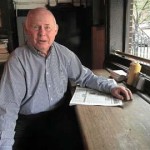The block bound by Astor Place, 3rd Avenue, East 9th Street, and 4th Avenue is today a huge construction site surrounded by a bustling neighborhood that will soon be reflected in the black glass skin of the building rising on the site. The project, known as 51 Astor Place, will sit on Cooper Union-owned land, where the school’s architecturally nondescript engineering building stood prior to this demolition. Interestingly, any building on land owned by Cooper Union does not pay city real estate taxes, but rather pays its taxes directly to the school as assistance to maintain its tuition-free education; the Chrysler Building, for instance, is located on Cooper Union-owned land. Therefore while 51 Astor Place will largely be a commercial office building, the building will still retain a connection, both physically and financially, to Cooper Union. The designer of the project, Edward Minskoff, has created a black glass and granite 11-story office tower that juts out in an asymmetrical, angular fashion. This is in stark contrast to the 6-story red brick and sandstone Bible House that once stood in its place.
Constructed in 1853, the Bible House was the office and printery of the American Bible Society. The Society was formed in 1816 by reform Christians. Their mission was to make the sacred text available to people of all backgrounds and they often accomplished this by undertaking huge canvasses across the nation. The first hotel bibles came from the Society, as did the first pocket bibles for soldiers during the Civil War. As early as 1818 the ABS had begun undertaking translations when they converted it into a Native American language. Their first permanent home came in 1822 at 72 Nassau Street, where they remained until relocating to Astor Place.
The erection of their stately Astor Place headquarters was financed by some of the city’s wealthiest residents. It was the first cast-iron framed structure built in New York City. According to a 2003 New York Times article by Christopher Grey, the printing technology here allowed the ABS to produce three bibles a minute, 24 hours a day. By the end of their stay on Astor Place they would have printed 77,000,000 bibles in 200 languages. Thousands of Christian tourists visited the building each year and even Mark Twain explored it. In Christopher Grey’s article he credits the Bible House with being the catalyst that brought forth countless publishers into the Astor Place corridor, turning it into what was known as “Book Row.”
A 1956 New York Times article marking the demolition of the Bible House stated, “In World War II the Bible House was used as an induction center. It is estimated that more men went into the military service from that building that from any other in this city except Grand Central Palace.” After 1953 the building was vacant except for a few ground level stores. Cooper Union purchased the land, demolished the Bible House in 1956, and in 1957, finished construction of their new engineering building. The American Bible Society is still headquartered in New York City, but now resides at Broadway and West 61st Street.


